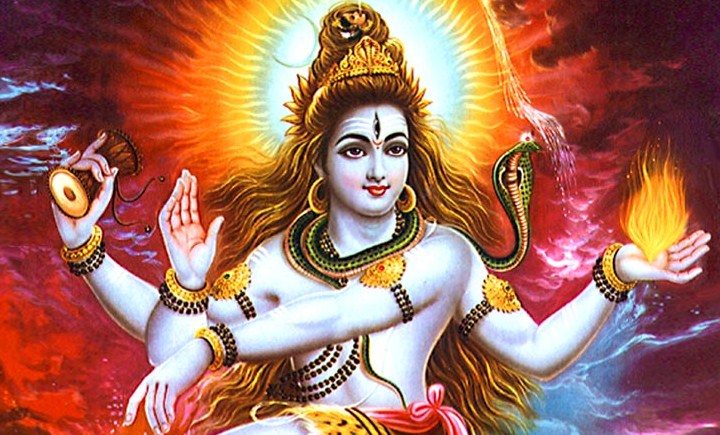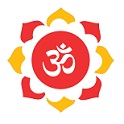No products in the cart.
Once Devi Parvati enquired of Mahadeva as to how to achieve Shivatwa and the latter said smilingly that Brahma too asked a similar query: in reply, Brahma visioned Parama Shiva in various Forms:
Yathaa twayaadya vai pushto drushtam Brahmaatmakam twaham,
Swetey Swetena varnena drushtwaa Kalpetu maam Shubhey/
Sadyojaatam tathaa raktey Vaamam Pitaamahah,
Peetey Tatpurusham Peetamayamaghorey Krishnameeshwaram/
Ishaanam Vishwarupaakhyo Vishwarupam tadaavamahaam/
(In Sweta Maha Kalpa, Shiva appears as of Sweta Varna or of Crystal Clear White Form called Sadyojaatam; in Rakta Kalpa, He is in Rakta Varna or of blood red colour; in yellow colour as Tatpurusha or as Aghora in dark colour and in Ishana Kalpa he saw Mahadeva as Vishwarupa. Brahma got rather confused then prayed to him as to in which form he should be worshipped:
Vaama Tatpurushaaghora Sadyojaata Maheswara;
Drushto mayaa twam Gayatrayaa Deva Deva Maheswaram,
Kena Vashyo Maha Deva dhyeyaha kutra Ghrunaanithey
drushyah pujayastathaa Devyaa Vkaktumarhasi Shankara!
( Vaama Deva! Tatpurusha, Aghora, Sadyojaata, Maheswara! You show me up along with Gayatri; kindly do indicate to me a way of my worship to you, meditate to you and pleae you!) Then Bhagavan affirmed:
Avomcha Shraddhayaiveti vashyo Vaarijasambhava!
Dhyeyo Lingey twayaa drushtey Vishnunaa payasaam nidhow,
Pujyayah Panchaasya rupena Pavitraih Panchaabhi Dwijaaih/
Bhava Bhaktaadya drushtoham twayaangna Jagadguro,
Sopi Maamaaha bhaavartham duttam tasmai mayaa pura/
Bhavam Bhaavena Deveshi drushtwaamnaam twadeeshwaram,
Tasmaad Shraddhayaa vashyo drushyah Sheshta Gireyh Sutey,
Pujyo Lingena Samdehah Sarvadaa Shraddhayaa Dwijaih,
Shraddhaa Dharmah Parah Sukshmah Shraddhaa Jnaanam hutam tapah,
Shraddhaa Swargascha Mokshascha drushyoham shraddhayaa sadaa/
(Kamalodbhava Brahma! I am worthy of being conquered by a devotee’s Shraddha or Sincerity and his/her meditation by all the Five Names as mentioned above; Vishnu who is on Ksheera Sagara too worshipped me by the Five Names (of Shiva). Brahma then replied that he also felt the same and worshipped Shiva likewise; Deva Parvati too thought in a similar manner as Shraddhaa would be the only way by which Shiva could be realised as that was the Parama Dharma, Sukshma Jnaana, homa, Tapas and the only means of Moksha, Swarga and so on.)
The Congregation of Munis then queried Suta Maha Muni to kindly explain the significance of each of the Five Names of Maha Deva and the latter replied that in the twenty ninth or Sweta Lohita Kalpa, Brahma was immersed in deep Tapasya facing West and from his tuft a Swarupa emerged suddenly with white complexion and as that Resplendent Form appeared unexpectedly and swiftly, Brahma named him Sadyojaata. Even as Brahma greeted the new Form of Shiva saying
Sadyojaatam prapadyaami Sadyo jaataayavai Namo Namah,
Bhavey Bhavenaati bhaveswaam bhavo bhaveybhyaanamah,
there materialised four disciples of Sadyojata viz. Sunanda, Nandana, Vishva Nanda and Upa Nanda who would always be in His presence. The Sishyas prayed to Sadyojata as: Vandeham Salam Kalankarahitam Staanormukham Paschimam.
In the Thirtieth Kalpa named Rakta Kalpa, Brahma meditated Bhagavan Shiva looking northward wearing Rakta Vastra and Rakta Varna and there appeared Vaama Deva who was of red colour and red ornaments; Brahma then saluted the Vaama Deva Form of Mahadeva as follows:
Vaama Devaaya namo Jyeshthaaya namah Jyeshthaayanamo Rudraaya namah Kaalaaya namah Kalavikaranaaya namo balavikaranaya namo balaaya namo balapramathanaaya namah Sarva Bhuta damanaaya namo manonmanaaya namah /
The disciples around Him were Viraja,Vibaahu, Vishoka and Vishwa Bhavana and these were of Rakta Varna, Rakta Vastra and Raktaabharana as their foreheads were smeared with rakta chandana, rakta bhasma, rakta lepana and rakta sindura. Innumerable Maharshis performed Tapasya to Vaama Deva and attained Shivatwa. Their prayers to Vaama Deva was:Vandey Purna Sashanka mandala nibham vaktram Harasyottaram!
In the next Kalpa numbered thirtyone called Peeta Kalpa, Brahma did Tapasya to Parama Shiva in the direction of East by assuming Peeta ( Yellow) Varna and Peeta Vastra and there emerged Tatpurusha (Brahma) of everything in Peeta colour donning Peeta Vastra-Aabhushana-Peeta Yagnopaveeta and Peeta Kireeta or Headgear. Brahma prayed to Tatpurusha stating Tat Purushaaya vidmahey Maha Devaaya dhimahi tanno Rudrah prachodayaat; along with the latter appeared a Sacred Cow Swarupa; that was of Devi Maheswareem :
Gaam Vishwarupaam drushey Maheswaramukha -acchytaam,
Chatush –padaam Chaturvaktraam Chaturhastaam Chatuhstaneem/
Chaturnetraam Chatuhshringeem Chaturdamshtraam Chatur mukheem,
Dwaantrih sadgunasamyuktaa meeshwareem Sarato-mukhaam/
(A Vishwarupa-Achyuta Maheswari with four feet, four mouths, four hands, four breasts, four eyes, four horns, four damshtras, four faces and of Sadgunas or Auspicious Traits). As Devi Gayatri appeared, Brahma performed ‘parikrama’ to the four-legged Sacred Cow called Gayatri and Maha Deva extolled her as Gayatri, Rudrani, Vaidiki and Vidya! Brahma assured that whosoever performed Japa and puja to her would please them with Shiva Tatwa and Shiva agreed to bestow on them DivyaYoga, Jnaana, Aishwarya and Vairagya. Besides Gayatri, there appeared several disciples who were also the close confidants of Gayatri, and who worshipped Parameshwara through Brahma Deva and they too assumed Peeta Varna-Peeta Vastra-Peeta Tilaka and every thing in Yellow colour.
In Praghrutta Kalpa of Black Varna after thousand of Deva years, Brahma prayed to Shankara towards South as he decided to create yet another Amsha of the latter, and consequently was materialised Aghora who was black in colour, all his body parts in black, wearing black Vastra, black ‘Janevu’ or Holy Thread, black headgear, black beads around his neck and was ornamented black too. Brahma prostrated before Aghora Rupa and prayed to him as follows:
Aghorebhyo taghorebhyo ghoratarebhyah,
Sarvebhyaassarva sarvebhyo namastey astu Rudra rupeybhyah
for thousand years and Maha Deva was gratified with the Tapasya and blessed that whosoever performed the Aghora Mantra one lakh times would be purified of the most severe sins including: Brahma Hatya Suraapaanam Suvarna steyamevacha or killing of Brahmana, consuming liquor, swindling gold etc. Aghora Deva’s sons were Krishna, Krishna Sikha, Krishna Mukha, Krishna Kanthadhaari and their prayer to Aghoresha is: Vandey Dakshinameeswarasya kutila bhrubhanga Roudram Mukham. The erring Brahmanas who committed Maha Patakaas are required to perform (after one lakh Aghora Mantra) seven Agni Homas with Ghee, Sugarcane, Tila or sesame seed orv atleast by ghee. After the required Havans, the Kartaas are to perform Snaanaas again by reciting the Aghora Mantra through out the night by sprinkling ‘Pancha Gavya’(Mix of Five Products of Cow viz. Milk, Curd, Dung, Urine, Ghee) and also consuming it for physical purification. By so performing, the erring humans especially Brahmanas would be observing ‘Prayaschitta’ or atonement of serious sins of even big magnitude including Bhruna Hatya, Brahma Hatya, Go hatya, Matru/Pitru Hatya, Bala Hatya, Stree Hatya, Mitru-Guru-Bhraatrum Hatya etc. At the beginning of Vishwa Kalpa, Brahma Deva initiated Srishti and Devi Saraswati was materialised first and Brahma greeted her saying :
Vishwamaalambaradhara Vishwa Yagopavartini
Vishwvoshneepaa Vishwagandhaa Vishwamaataa Mahoshtika/
There after, Brahma created Ishana who was of Shuddha sphatika sankaasam or like Transclucent Prism and Saravaabharana bhushitam or decorated by all kinds of ornaments whom Brahma commended as follows:
Vavandey Devameeshaanam Sarveysam Sarvagum Prabhum,
Omeeshaana Namastestu Maha Deva namostutey/
Namostu Sarva Vidyaanaa -meeshana Parameshwara,
Namostu Sarva bhutaanaameeshaana Vrishavaahana/
Brahmanodhipatey tubhyam Brahmaney Brahma rupiney,
Namo Brahmaadhipataye Shivam mestu Sadaa Shiva/
Omkaara murtey Devesha Sadyojaata namonamah/
Prapadye twaam prapannosmi Sadyojaataaya vai namah/
Abhavecha Bhavey tubhyam tathaa naati bhavey namah,
Bhavodbhava Bhaveshaana maam bhajaswa Mahaadyutey/
Vaamadeva Namas -tubhyam Jeyshthaaya Varadaayacha,
Namo Rudraaya Kaalaaya Kalanaaya namo namah/
Namo Vikaranaayaiva Kaalavarnaaya vahniney,
Balaaya Balinaam Nityam sadaa Vikaranaayatey/
Bala Pramathanaayaiva Baliney Brahmarupiney,
Sarva Bhutashwareshaaya Bhutaanaam damanaayacha/
Manonmanaaya Devaaya Namastubhyam Mahaadyutey,
Vaama Devaaya Vaamaaya Namastubhyam Mahaatmaney/
Jyeshthaayachaiva Shreshthaaya Rudraaya varadaayacha,
Kaalahantrey Namastubhyam Namastubhyam Mahaatmaney/
Iti stavena Devesham nanaama Vrishabhadhwajam,
Yah Pathet Sakru deveha Brahmaloka -mavaapnuyat/
( My salutations to you Ishana, Mahadeva, Sarwa Vidyaa Swaami, Sarva Parameshwara, Vrishabha Vahaana, Brahmadhipati, Brahma Swarupa, Omkara Murti, Devasha, Sadyojaata; the Abhava or the One who has not occurred, yet the Bhava or the One who has occurred and is a Great Occurrence; Ishana, Maha Shobha, Vama Deva, Jyeshtha, Varada or the Bestower of Boons, Rudra, Kaala, Kaalaa’s Kaala, Vikaranaya, Kaala Varnaaya, Balaaya, Bala Manthanaaya, Brahma Swarupa, Sarva Bhuta Swami, Bhuta damanaaya, Manmatha damanaaya,Sreshthaaya, Rudraya, Kaalahantrey! Who ever recites the above Stuti would qualify for Indra and Brahma lokas!) As Shiva was pleased with Brahma’s eulogy, Dervi Sarasvati also got materialised along with Pancha Mukha Rudras; she too who was Chatur Mukhi-Chatur Baahu-Chatur Pada and Chatur-Netri was Viswarupa as she was born in that Kalpa who too had as Brahma Gunas like Yoga, Samkhya, Tapa, Vidya, Vidhi Kriya, Dama, Satya, Daya, Ahimsa, Sammati, Kshama, Dhyana, Dheya,Shanti, Mati, Dhruti, Kanti, Neeti, Medha, Lajja, Tushti, Pushti, Kriya and so on; she was also Gauri Maya, Vidya, Hemavati, Pradhana Prakriti, Ajanma, Lohita, Shukla-Krishna, Vishwa Janani, Gayatri and Go Swarupa! Such was the significance of Devi Saraswati, stated Maha Deva.
Disclaimer : Compiled, Composed and Interpreted by V.D.N.Rao and first appeared on Kamakoti.org







